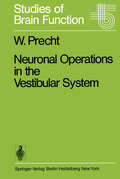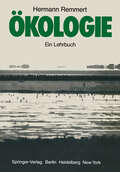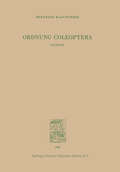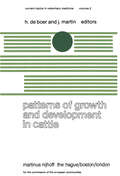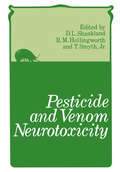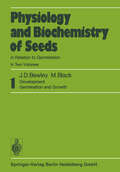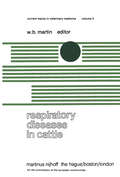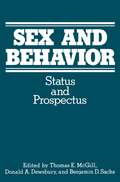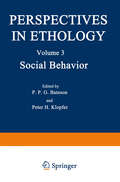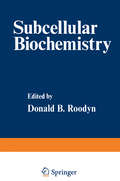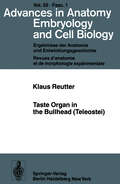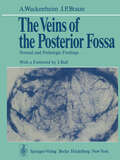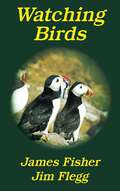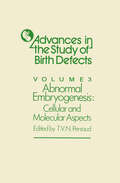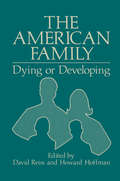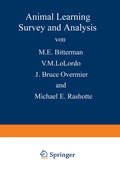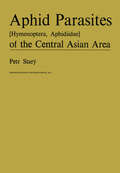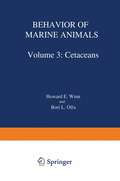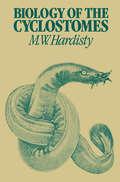- Table View
- List View
Neuronal Operations in the Vestibular System (Studies of Brain Function #2)
by W. PrechtThe original intent of the series Studies of Brain Function was to offer a forum to neurobiologists working in different fields to present some of their recent results in a more extensive way. What may have been or might be published in several papers appearing in different journals will thus be com bined in one monograph, thus making the data more easily available to a wider scientific community. It is also believed that such an attempt will provide a more comprehensive insight into one particular field of neurobiol ogy. Admittedly, the monograph will represent a more subjective view than that provided by a classical review article. In this monograph I am going to describe a major aspect of my research, i.e., the central processing of information arising from the receptors in the semicircular canals and otoliths of the inner ear. I shall restrict this report to those systems that are concerned with the vestibuloocular transmission, since they offer particular opportunity to study sensory-motor integration.
Parkinson’s Disease—II: Aging and Neuroendocrine Relationships (Advances in Experimental Medicine and Biology #113)
by C. E. FinchThese Proceedings emanate from the Second Tarbox Parkinson's Disease Symposium held February 2-4, 1978, at the SouthPark Inn in Lubbock, Texas. The Symposium was sponsored by the Tarbox Parkin son's Disease Institute and the Department of Pharmacology and Therapeutics of the Texas Tech University School of Medicine at Lubbock. The First Symposium took place in October, 1976. The Second Tarbox Parkinson's Disease Symposium boldly brought together investigators at the cutting edge of aging and neuroendo crine research and attempted to relate them to Parkinson's disease. Credit for the concept must go to the Program Chairman, Dr. David E. Potter. Once the plan was conceived the organizers relied heavily on the advice of Dr. Caleb E. Finch, whose counsel in developing the program was invaluable. The final verdict on the success of this daring venture must await the outcome of the publication of this Volume. Nevertheless, those in attendance could not fail but note the enthusiasm and excitement of the participants as their findings from the diverse disciplines of the neurological, aging, and endo crine sciences converged. This in itself is testimony that the Sym posium accomplished some degree of success. The Tarbox Parkinson's Disease Institute was established in 1973 with funds appropriated by the State of Texas and is dedicated to research, patient care, and education in Parkinson's disease and related neurological disorders. The Institute is named after Mr.
Patterns of Growth and Development in Cattle: A Seminar in the EEC Programme of Coordination of Research on Beef Production held at Ghent, October 11–13, 1977 (Current Topics in Veterinary Medicine #2)
by H. De Boer J. MartinThis publication contains the proceedings of a seminar held in Ghent, Belgium on October 11th-13th 1977, under the auspices of the Commission of the European Communities, as part of the EEC programme of co-ordination of research on beef production. The seminar was initiated by the scientific working group on 'Carcass and Meat Quality' and attracted the interest of the working groups on 'Genetics and Selection' and on 'Nutrition and Management'. Consequently it developed into a multi-disciplinary programme, organised under the responsibility of the working group on Carcass and Meat Quality. This group comprised Ir. H. de Boer (Chairman), Netherlands; Prof. R. Boccard, France; Dr D.E. Hood, Ireland; Dr R.W. Pomeroy, UK; Dr A. Romita, Italy; Professor Dr L. Sch~n, Fed. Rep. of Germany; Mr P. L'Hermite, CEC; and Dr J.C. Tayler, UK (adviser to the CEC). In view of the broad scope of the subject, a special plan ning meeting was organised, involvi.ng experts from the different disciplines involved. The additional participants were: Dr B. Bech Andersen, Denmarkj Dr A.J.H. van Es, Netherlands; Prof. Dr J. Martin, Belgium; Dr. St.C.S. Taylor, UK. The multidisciplinary scope of this ~eminar follows a series of seminars in 1975-76 on more specific aspects of beef production research in the individual fields involved. It seems logical that further seminars should integrate the approaches by different disciplin~s in order to achieve a balanced programme of research on the very complex topic of beef production.
Penguin Readers Level 1: Roald Dahl The Enormous Crocodile (Penguin Readers Roald Dahl)
by Roald DahlLearn English with The Enormous Crocodile! A Penguin Readers book. Discover fifteen famous Roald Dahl adventures, adapted for learners of English aged 7+. Can you read them all?Penguin Readers is an ELT graded reader series for learners of English as a foreign language. Readers include simplified text, illustrations and language learning exercises. Please note that the eBook edition does NOT include access to the audio edition and digital book.In these Penguin Readers editions, Roald Dahl's stories have been aligned to the CEFR framework A1 to A2+, in four levels. Each book is also Lexile measured. The graded readers feature illustrated new words, language activities, and fun games between chapters, encouraging students and teachers to structure learning and make real progress. Every book also includes projects and discussions.Visit the Penguin Readers website for downloadable quizzes, worksheets and answer keys. Exclusively with the print edition, readers can unlock a digital book and audio edition (not available with the eBook).The Enormous Crocodile, a Level 1 Reader, is A1 in the CEFR framework. Short sentences contain a maximum of two clauses, introducing the past simple tense and some simple modals, adverbs and gerunds. Illustrations support the text throughout.The Enormous Crocodile is hungry, and children are his favourite food! Can he f ind a child for his lunch? Or can the Hippopotamus, the Elephant, the Monkey and the Bird stop him?
Physiology and Biochemistry of Seeds in Relation to Germination: 1 Development, Germination, and Growth
by J. D. Bewley Michael BlackProceedings of the 2nd International Symposium on Trichoptera: University of Reading, England, 25–29 July 1977
by M. I. CrichtonThe 2nd International Symposium on Trichoptera was held at the University of Reading, England, 25-29 July 1977. It attracted 68 participants from 22 countries, which was a gratifying response to the circulation of about 250 workers on caddis flies. It was H. MALICKY who appreciated the need for a specialized meeting of this kind and organized the 1st International Symposium on Trichoptera, which was held at Lunz am See, Austria, 16-20 September 1974. This volume of Proceedings includes 38 papers; all except one were presented and discussed in the sessions listed in the programme. The papers were given in a lecture theatre of the Palmer Building, and demonstrations were laid out in a laboratory of the Department of Zoology where members met for their mprning and afternoon breaks. Members were accommodated in St Patrick's Hall, one of the University Halls of Residence. They were the guests of the University at an informal reception on 25 July. On the afternoon of 27 July an excursion was made to the River Lambourn at Bagnor near NeWbUry. This chalk stream has been the subject of an ecological study by a team from the Department of Zoology since 1970. The excursion was also an opportunity to see something of the local caddis fauna, and to do some collecting. The final session on 29 July, under the chairmanship of G. B. WIGGINS, was followed by a discussion on future plans.
Respiratory Diseases in Cattle: A Seminar in the EEC Programme of Coordination of Research on Beef Production held at Edinburgh, November 8–10, 1977 (Current Topics in Veterinary Medicine #3)
by W. B. MartinNot so many years ago little attention was paid to non-parasitic respiratory diseases of cattle because they seemed of minor importance. However, in the past twenty years, as the number of cattle kept on any farm unit increased under economic pressures, there has been a concomitant rise in the prevalence of respiratory illness. Investigations into cattle respiratory diseases have become a significant part of the research effort in most countries of Europe. Initially much work went into finding, like the alchemist's stone, the orgdnism responsible for causing cattle respiratory disease. Many viruses were isolated and over the years a long list of those recovered from the respiratory tract of cattle has been prepared. Unfortunately, few of these viruses on their own are recognised as proven pathogens and no single virus provides the complete aetiological answer to bovine respiratory disease. More recently, perhaps in despair, g~eater attention has been directed to the role of mycoplasma and, additionally. a revival of interest has taken place in the significant part played by bacteria in the later stages of res piratory disease. Now, phrases such as "multifactorial disease" are being commonly used to describe the complex situation with respiratory disease.
Richard Scarry's Postman Pig and His Busy Neighbours
by Richard ScarryJoin Richard Scarry's beloved Postman Pig for a day of discovery and adventure! With deliveries to the police station, the doctor's office, the library and many more, young readers will see how those in their communities go about the day. This classic story is, indeed, a very special delivery.Praise for Richard Scarry:'Awe-inspiring.' Dapo Adeola'Treasure troves of detail.' Chris Mould'A delight.' Sara Ogilvie'What a talent.' David Tazzyman'One of my favourite illustrators.' Allen Fatimaharan
Sex and Behavior: Status and Prospectus
by McgillDiscussion of the precise nature and position of boundaries between dis ciplines is nearly always counterproductive; the need is usually to cross them not to emphasize them. And any such discussion of the distinction between ethology and comparative psychology would today seem patently absurd. While there may be differences in outlook, no boundaries exist. But when Frank Beach started in research, that was not the case. Comparative psychology flourished in the United States whereas ethology was unknown. Beach started as a comparative psychologist and has always called himself either that or a behavioral endocrinologist. Yet, among the com parative psychologists of his generation, he has had closer links with the initially European ethologists than almost any other. He was indeed one of the editors of the first volume of Behaviour. That this should have been so is not surprising once one knows that his Ph. D. thesis concerned "The Neural Basis for Innate Behavior," that he used to sleep in the laboratory so that he could watch mother rats giving birth, and that in 1935 he was using model young to analyze maternal behavior. Furthermore, for nine years he worked in the American Museum of Natural History-in a department first named Experimental Biology and later, when Beach had saved it from extinction and become its chairman, the Department of Animal Behavior. It was in 1938, during Frank's time at the American Museum, that he was first introduced to Niko Tinbergen by Ernst Mayr.
Social Behavior (Perspectives in Ethology #3)
by P. BatesonSociobiology is the play of the season. Its success is mellsured by its immense popularity and perhaps by the controversy it has generated as well. Unfortunately, neither its popularity nor the resulting controversy seems likely to assure progress toward understanding sociobiological issues. The play has too many actors and, it seems, the casting has been poor; the players are unable to maintain their roles. At center stage, of course, is E. O. Wilson and his monumental opus Sociobiology. 1 In the wings, and making periodic entrances, are an assort ment of brilliant, committed, and aggressive adversaries. On cue, one of them steps out and decries the self-fulfilling nature of sociobiological prophesies. The arguments of the adversaries are varied. They warn that if all nonhuman primate societies tolerate aggression and man is also a pri mate, then aggression may come to be considered "normal" and therefore acceptable. Their dire warnings may also have real impact on policy, alter ing, for example, a research program intended to examine longitudinally the relation between a supernumerary chromosome and certain behavioral disorders. The rationale is that since the afflicted infants would have to be identified and the study obviously does assume that psychopathology is linked to the chromosome aberration, the attitudes of the child's parents could well contribute to abnormal behavior that might otherwise not appear.
Subcellular Biochemistry: Volume 5
by Donald RoodynThe transition from the quarterly Sub-Cellular Biochemistry to the annual SUBCELLULAR BIOCHEMISTRY is a good opportunity to restate the aims and scope of this publication. They were originally given (in Volume 1 No. 1) as follows: This review and essay journal . . . brings together work on a wide range of topics in sub-cellular biochemistry in the hope of stimulating progress towards an integrated view of the cell. It deals with the biochemistry and general biology of nuclei, mitochondria, lysosomes, peroxisomes, chloroplasts, cell membranes, ribosomes, cell sap, flagellae and other specialized cell components. In addition to articles dealing with conventional biochemical studies on sub-cellular struc tures, the journal publishes articles on the genetics, evolution and biogenesis of cell organelles, bioenergetics, membrane behaviour and the interaction between cell structures, particularly between nucleus and cytoplasm. The first four volumes (in the quarterly format) fulfilled many, but not all, of these stated aims, and it is hoped that further articles in the new annual series will soon fill any deficiencies in the range of topics covered. Over the years we have intentionally not interpreted the title of the publication in a too literal sense. Although we have included specific articles on individual subcellular fractions (and certainly hope to do so again) the publication is definitely not only concerned with studies on the biochemistry of isolated cell fractions. The primary target is the "integrated view of the cell.
Taste Organ in the Bullhead (Advances in Anatomy, Embryology and Cell Biology #55/1)
by Klaus ReutterIn fish, the sense of taste is extraordinarily highly developed and essentially more sensitive than that of mammals. This is due to chemoreception, which offers suf ficient possibilities for animals living in water to orient and maintain themselves suc cessfully in individual and social life. Therefore, at least within the vertebrates the chemical senses have developed to their highest standard in water. Chemoreception is evidently present in land-dwelling mammals and is still dependent on moist surfaces, but the optical sense, in its highest stage of development, takes priority. In contrast, in aquatic animals vision generally plays only a subordinate role (c. f. Grant & Mackie, 1974). Although the high sensitivity of the sense of taste in fish has been extensively shown in physiological experiments, corresponding detailed morphological data are lacking. Due to their similarity the taste organs of fish and mammals have been regard ed equally or rather the results taken from fish have been interpreted on the basis of the known morphology of the mammalian taste bud (TB). However, the high efficien cy of the sense of taste in fish requires a corresponding morphological basis, and mor phological and histochemical particularities can indeed be cited as examples: firstly, TB in fish are not only located in the mouth and throat area, but in many species also in the outer skin of the body.
The Veins of the Posterior Fossa: Normal and Pathologic Findings
by A. Wackenheim J.P. BraunIt is a privilege and pleasure to write a foreword to this work. Who, twenty years ago, would have thought that a whole book could be devoted to the veins of the posterior fossa? Even today the standard text-books of anatomy only give a paragraph to the subject. Thanks to the dedicated work of rather a few neuroradiologists our knowledge has now reached a very sophisticated level. The careful correlation of anatomical dissection with the angiographic image has achieved this, but without the aid of subtraction (discovered by a world figure in neuroradiology - Professor ZIEDSES DES PLANTES) the subject would not be as advanced as it is. The authors are to be congratulated not only for presenting the most up to date anatomical information but also for showing how wide the applications are in the clinical field by the careful analysis of displacements of veins, many of which were quite unrecognised only a very few years ago. Drs W ACKENHEIM and BRAUN are in the forefront of this discipline to which they and the French school have contributed so much. Also it was their great enthusiasm and drive which led to the birth of the European Society of Neuroradiology, the first meeting of which was held in Colmar in September 1969. The Society has flourished under their guidance and very successful annual meetings have been held for nearly a decade.
Watching Birds (Poyser Monographs #118)
by James FisherThis revised edition of the late James Fisher's much praised Watching Birds is the work of Dr Jim Flegg, Director of the British Trust for Ornithology. In his Preface Dr Flegg writes: "It is a daunting task to revise the bird book on which you cut your teeth: it is the surest measure of the man who wrote it that what is needed, after thirty-odd years, is an updating and not a sweeping revision." Among James Fisher's deservedly popular writings Watching Birds was probably the most read and consulted. After several reprints (published by Penguin Books) he planned to re-write it, and it is wholly appropriate that the work should now be done by Dr Flegg who, like the original author, has done much to help arouse and stimulate a widening interest in watching and understanding the life and world of birds. It is an indication of that interest today that radio and TV programmes (in which Dr Flegg has frequently participated) have audiences of millions. Such numbers are hardly surprising since few leisure activities offer as effective or as gratifying an antidote to the pressures of modern life as birdwatching - and few can be as readily and inexpensively pursued at almost any time, anywhere.Watching Birds has been an introduction and an item of basic equipment to tens of thousands of birdwatchers in the past, and this new and revised edition is assured of an even wider audience.
117 Things You Should F*#king Know About Your World: The Best of IFL Science
by IflscienceDid you know your irises are lying to you and all human eyes are actually brown?Want to know the absolute worst way to die, according to science? Did you know that a smoking psychedelic toad milk could alleviate depression for up to four weeks?117 Things You Should F*#king Know About Your World tells you the answers to these questions and many more weird and wonderful facts about the universe. Split into the site's different subject areas of environment, technology, space, health and medicine, plants and animals, physics and chemistry, this is the ultimate science book. With 25 million social media followers, I F*#king Love Science is the world's favourite source of science on the web. From missing nuclear weapons and Facebook secret files to the world's smallest computer and why you should wrap your car keys in tinfoil, this is the book that only the world's leading source of crazy-but-true stories could produce.
Abnormal Embryogenesis: Cellular and Molecular Aspects (Advances in the Study of Birth Defects #3)
by T. V. N. PersaudThe study of birth defects has assumed an importance even greater now than in the past because mortality rates attributed to congenital anomalies have declined far less than those for other causes of death, such as infectious and nutritional diseases. It is estimated that as many as 50% of all pregnancies terminate as miscarriages. In the majority of cases this is the result of faulty development. Major congenital malformations are found in at least 2% of all liveborn infants, and 22% of all stillbirths and infant deaths are associated with severe congenital anomalies. Teratological studies of an experimental nature are neither ethical nor justifiable in humans. Numerous investigations have been carried out in laboratory animals and other experimental models in order to improve our understanding of abnormal intrauterine development. In less than two decades the field of experimental teratology has advanced phenomenally. As a result of the wide range of information that is now accumulating, it has become possible to obtain an insight into the causes, mechanisms, and prevention of birth defects. However, considerable work will be needed before these problems can be resolved. The comributions in this volume include some of the more recent and exciting observations on the cellular and molecular aspects of developmental defects. It is not only a documentation of the latest experimental work, but it also indicates new and important areas for future research.
The American Family: Dying or Developing
by Howard HoffmanSeveral years ago, an anonymous donor gave a generous gift to the Department of Psychiatry and Behavioral Sciences at George Washington University School of Medicine. The donor suggested that the gift be used to support a conference on the current dilem mas of the American family and to publish its proceedings. The current chairman of the department, Jerry Wiener, formulated the initial plans for the conference with Leon Yochelson, who had been chairman at the time the gift was made. Dr. Yochelson is now Chairman of the Board of the Psychiatric Institute of the District of Columbia. These initial discussions led to a significant and sus tained collaboration between the Department of Psychiatry and Behavioral Sciences at George Washington and the Psychiatric In stitute in planning the conference and the present volume. A committee was established to plan the conference. It con sisted of Peter Steinglass, Associate Professor of Psychiatry, and George Cohn, Professor of Child Health and Development, both of George Washington, and Margaret Garrett, a member of the psychiatric staff at the Psychiatric Institute. The committee was jointly chaired by the editors of this volume. The committee re ceived indispensable assistance from members of the administra tive staff of the Psychiatric Institute: Al Bruce, Carol Klein, and Miriam Mathura. Margaret Schnellinger of the Center for Family Research, George Washington University, was also very helpful in all phases of planning the conference.
Animal Learning: Survey and Analysis (Nato Science Series A: #19)
by M. E. Bitterman V. M. LoLordo J. Bruce Overmier Michael E. RashotteFor ten days, a number of neuroscientists met at Reisensburg to attend a series of lectures and discussions, an Institute, on animal learning. The students were drawn from a wide variety of disciplines, including anatomy, biochemistry, pharmacology, physiol ogy and zoology. It is probably true to say that many of them had at best a sketchy knowledge about the learning behavior of animals, about the conditions which are necessary for learning to take place and about the theories that psychologists have constructed about the learning processes. Was the Institute of any benefit to those neuro scientists whose interests lay in studying the functioning of the nervous system by manipulating it or probing it in some direct way? Some twenty years ago the answer to this question would probably have been "No"; and there is a very good reason why this view might have been held, especially by students of the mammalian nervous system. At that time most investigators used anaesthetised animals, or animals immobilized in some other way such as by surgically isolating the brain from the spinal cord, by dividing the brain at various levels or through the use of paralyzing agents. These con ditions achieved two things. On the one hand, they allowed sub stantial advances to be made, particularly in the analysis of sensory processing and in the analysis of the neuronal mechanisms of relatively simple reflex action. On the other hand, the experi mental conditions virtually eliminated complex behavior.
Aphid Parasites (Hymenoptera, Aphidiidae) of the Central Asian Area
by P. StarýAn analysis of the particular topics in biological control programmes all over the world indicates an increased interest in the utilization of aphid parasites. Besides the so-called traditional biological control of introduced aphids, there appears a situation which could perhaps be called a renaissance of biocontrol, i. e. the utilization of biotic agents against insecticide-resistant populations of aphid pests. The rapid increase in the amount of information as well as the necessity of syntheti cal papers are the well-known features in today's entomology. This requirement is much more topical in the groups where brief summarized information is needed for research workers in applied branches. The author has been well aware of all these difficulties and requirements owing to his own experience both in basic and applied research. Several years ago he decided to summarize our knowledge on the aphid parasites of the world by elaborating synthetical studies on the particular zoogeographical areas. These papers have been intended to represent annotated reviews of the parasite fauna, distribution, biologies and utilization in aphid pest management, with keys to genera and species, hos- parasite catalogue, and a list of references added. Naturally, these studies are only relatively updated, with respect to a certain deadline from which the research may be further continued. At present, the Far East Asian and the Mediterranean areas have been reviewed in this or at least in a similar manner.
Behavior of Marine Animals: Current Perspectives in Research
by Howard E. Winn Bori L. OllaFour years ago we began soliciting articles for this volume from authors who were engaged in comprehensive research on whales. From the outset we decided not to limit the subject matter to behavior but to also include natural history. Much of what is known about the behavior of whales arose from studies whose principal aim was not behavior, much as it did for other animal groups before behavior was considered a distinct discipline. Thus in many of the articles behavior is closely intertwined with natural history and in others is completely overshadowed by a basic natural history approach. Our aim was to have the articles contain a review of the literature and include research findings not previously published. For all intents and purposes this aim has been realized, albeit perhaps not in as balanced a fashion in terms of species or subject matter as was originally planned. Nevertheless, we believe the articles present a wide range of informative works with a myriad of approaches and techniques represented. We are grateful to the contributors for their patience and understanding in awaiting publication, which has taken much longer than we originally expected. We are also grateful tor the assistance of a number of people, especially Julie Fischer and Lois Winn for their editorial efforts, and Jill Grover, Carol Samet, and Lois Winn for their help in indexing.
